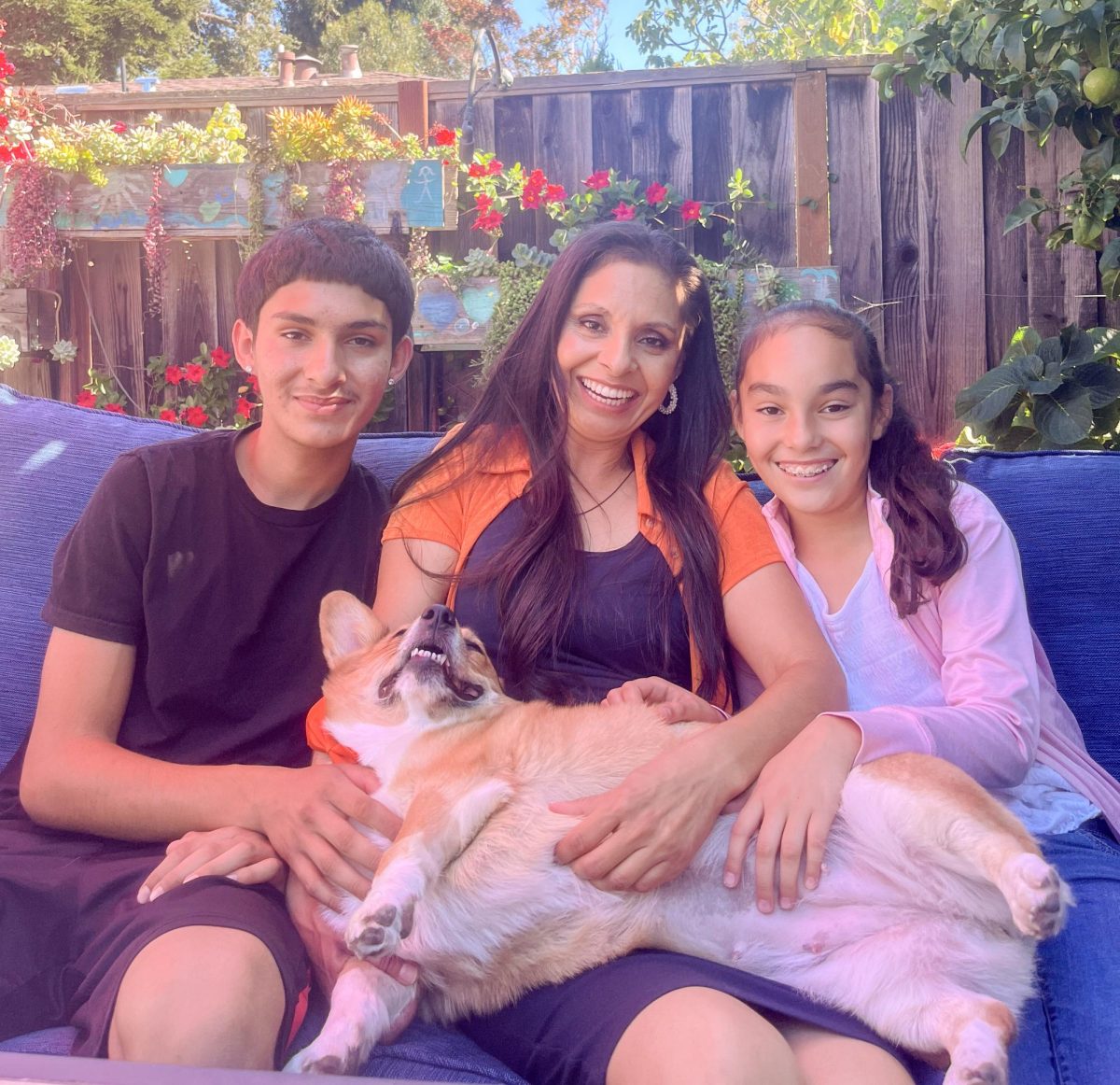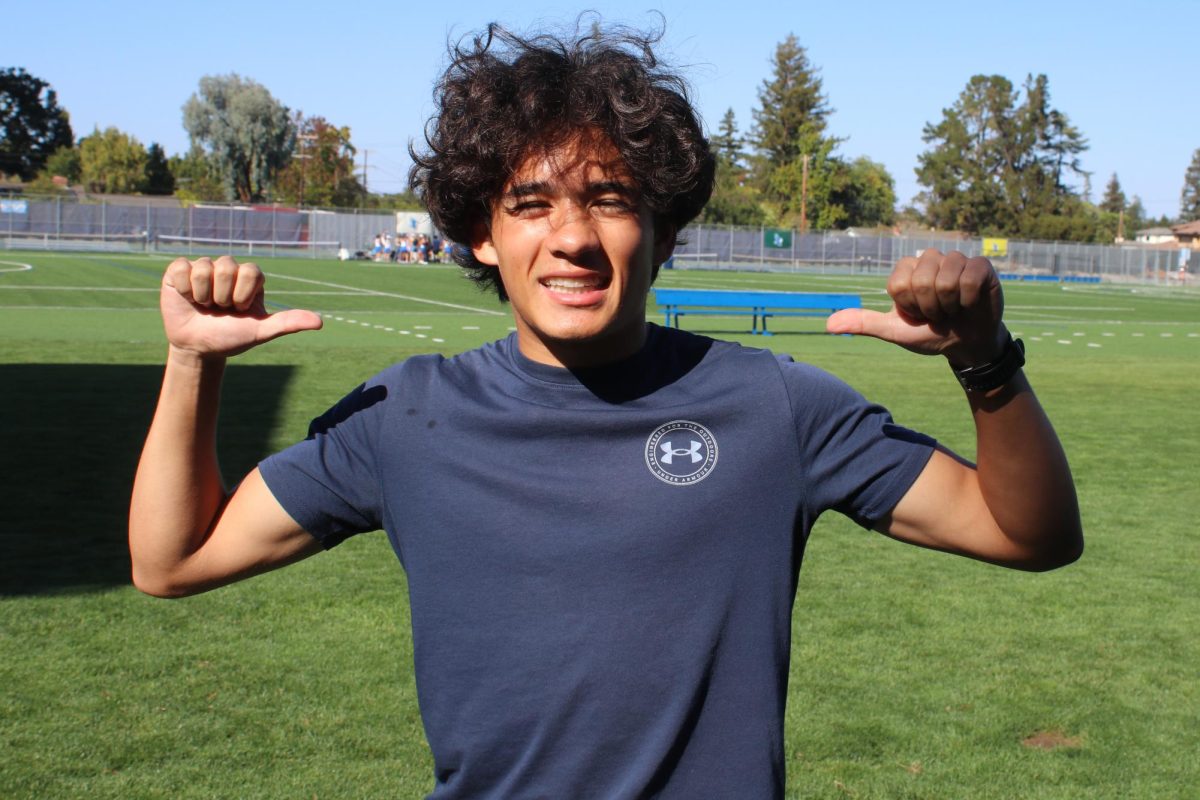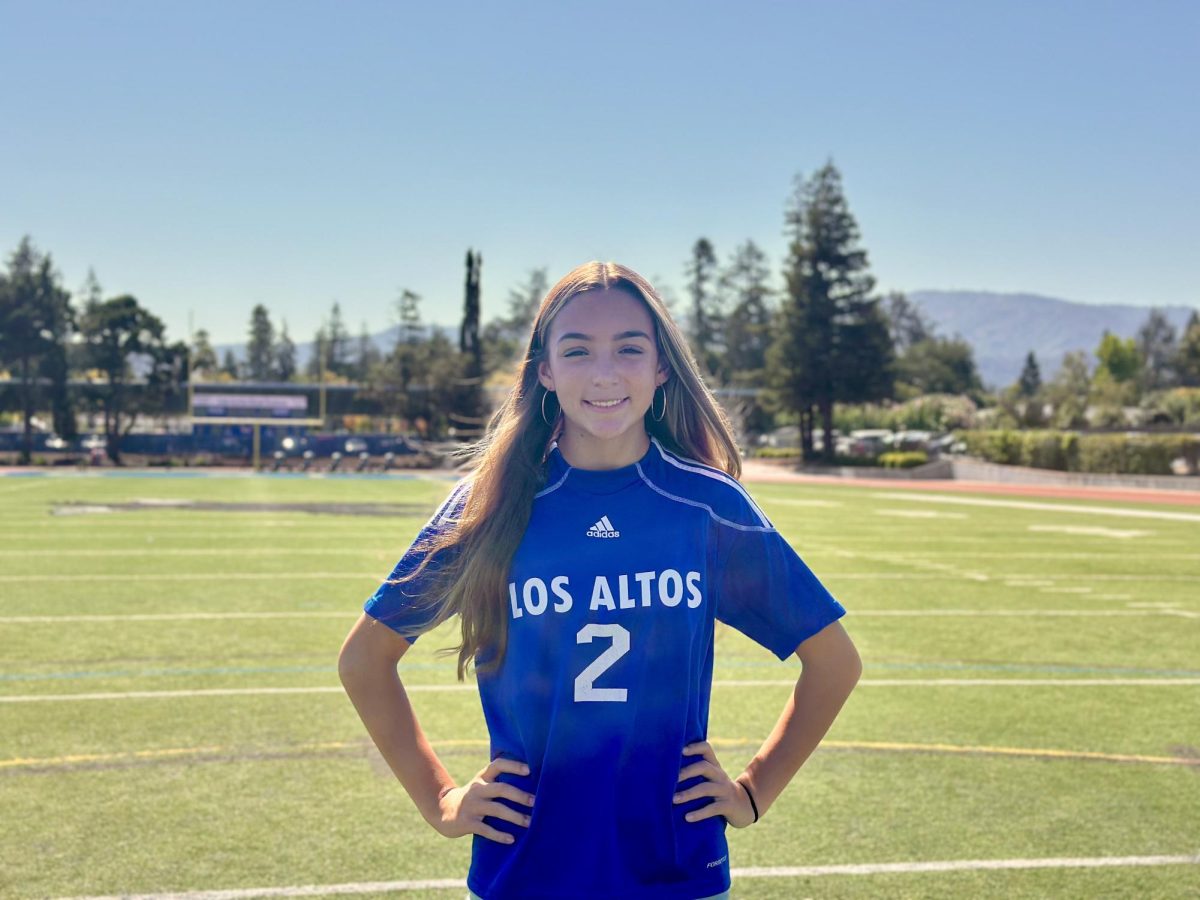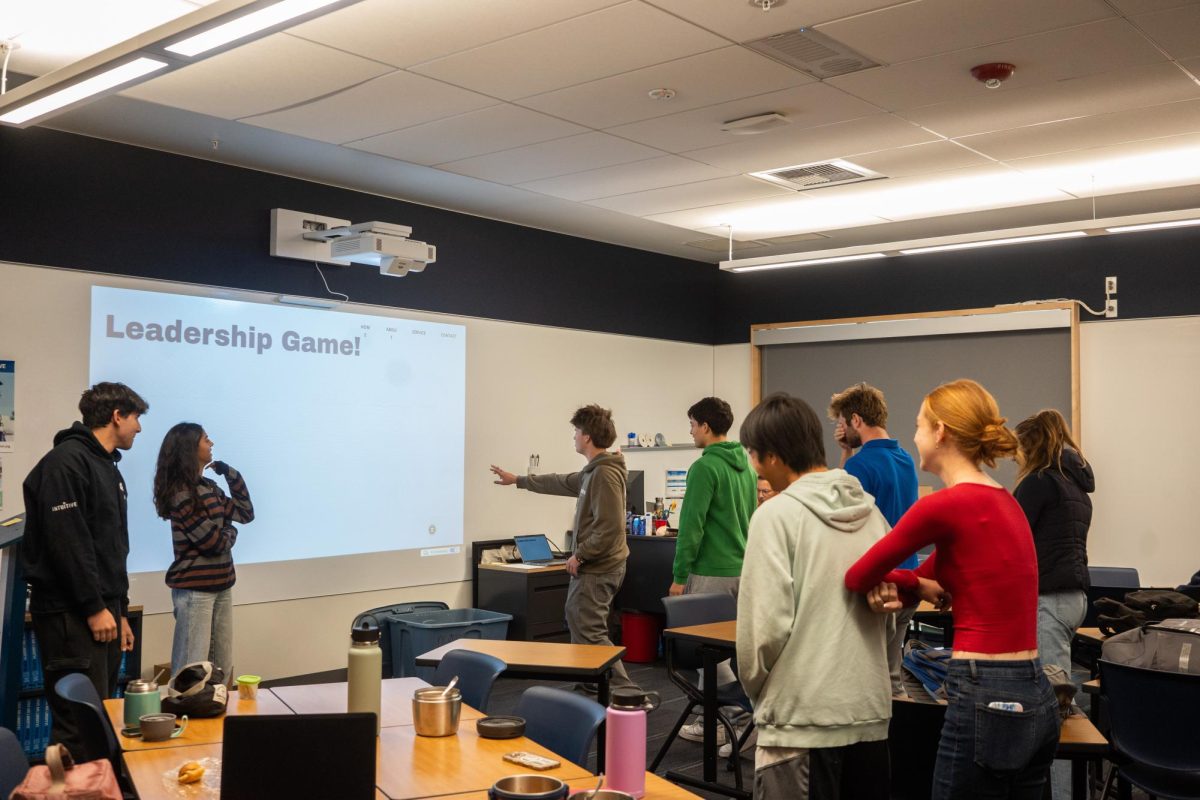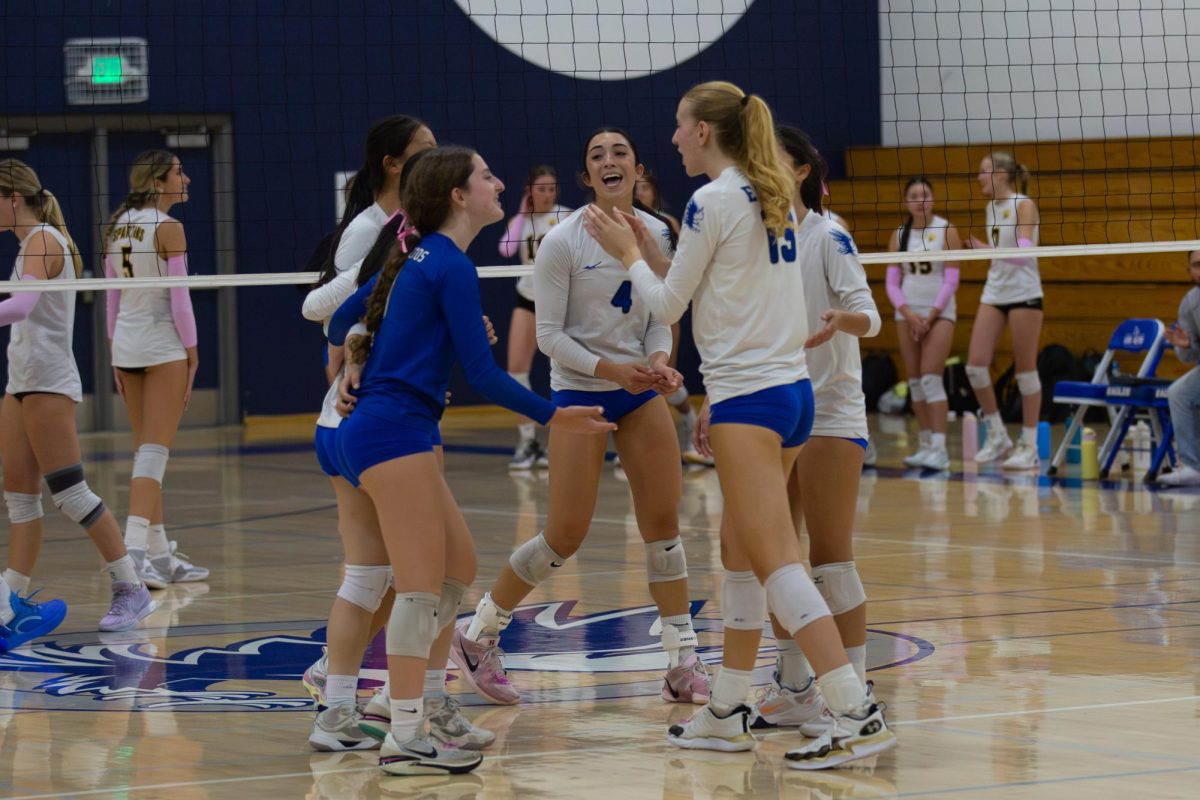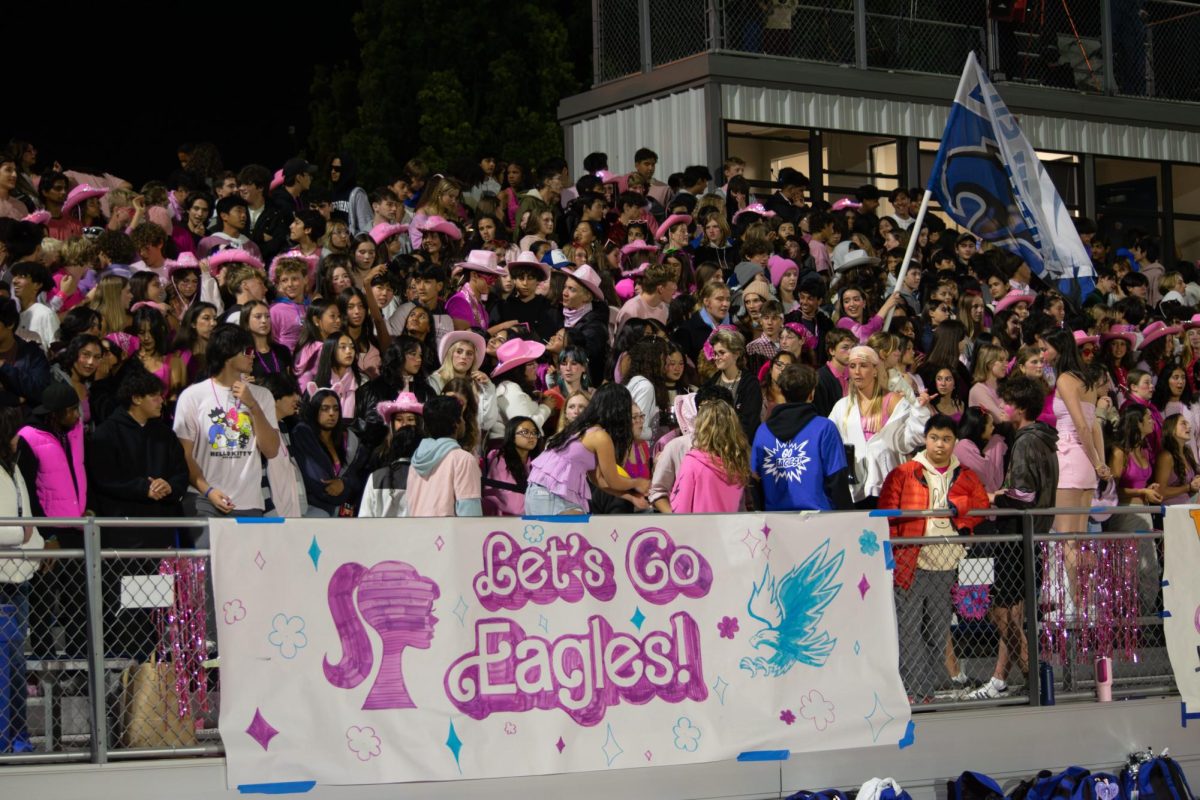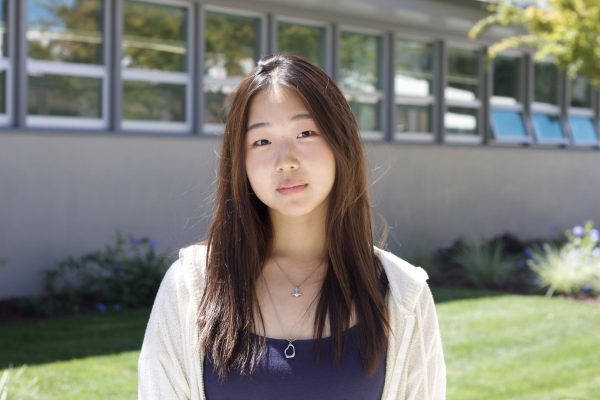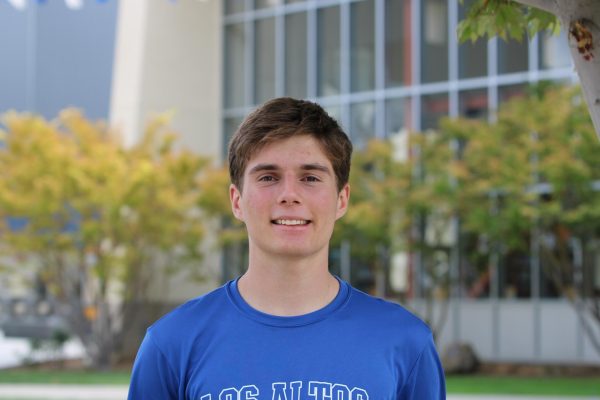
Junior Avni Rajogopal wants to revolutionize AI in scientific research. As AI becomes more prevalent in science, she aims to improve its ability to collect information.
Avni uses Retrieval-Augmented Generation (RAG), a technique used to improve how large language models (LLMs) access information.
“When kids come to talk about AI, I’m like, ‘Okay, what’s the application?’” ASI Teacher Darren Dressen said. “When she told me that she was using RAG to look up science articles, I thought that was a really cool idea.”
RAG goes beyond using what the model was trained on, allowing the LLM to access documents relevant to the user’s input and return more accurate responses. Her project applies this technique to scientific papers, aiming for accuracy from the machine.
“Using those models can make scientific literature easier to parse through,” Avni said. “It can make that process faster and act as a great tool.”
Her project focuses specifically on smaller LLMs, such as Llama, which don’t have the same extensive training compared to models like ChatGPT. Instead of training it on more data, Avni uses RAG to increase its accuracy, aiming to optimize its ability to pull from sources.
“For me, I’ll go to Google Scholar to find articles which is hard,” Dressen said. “With her system, it would just do a much better job of retrieving that information and giving you what you’re really looking for.”
So far, Avni’s research has yielded promising results and supported her hypothesis — RAG increased precision and decreased hallucinations.
“By increasing the number of parameters in the model, I found that actually all of the Llama tests passed when they were using RAG,” Avni said.
These results imply that in the real world with limited resources, RAG truly helps smaller LLMs perform at higher levels.
“I was really excited as it proves the real-world significance of getting these models to perform high and lessening the amount of resources being put in,” Avni said.
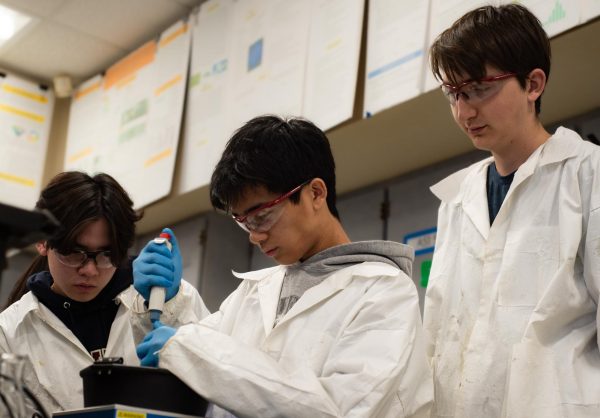
(Milan Grbovic)
Seniors Joseph Gerdyman and Parker Woo and junior Tom Eskanazi were the only group in the Chemistry-focused ASI classroom that qualified for the California Science and Engineering Fair for their research on using perovskite films as an application for solar panels.
Their project aimed to make solar energy cheaper and more efficient by using perovskite solar cells — an alternative to traditional silicon-based solar cells. Since perovskite solar cells are inexpensive and easy to manufacture but quickly degrade in efficiency when exposed to moisture or oxygen, the team wanted to find a way around that problem.
“The idea is to make perovskites more stable by investigating these molecules called ligands,” Tom said. “When perovskites degrade, their structures get messed up, so the ligands go and bind to it, stopping it from degrading.”
By making perovskite solutions and different ligands, the trio made films that they would place onto glass and observe which ligands worked best by increasing the lifetime of the solar panel.
“Tom has been our ligands guy, so he’s been doing a lot of literature review and understanding why molecules work and telling us which ones to pick,” Parker said. “Joseph and I have been more in the lab, making the actual films.”
But they weren’t initially a trio. When Joseph and Parker applied to ASI together last spring as partners, they were quickly paired with Tom since their projects all involved solar energy. Dressen said each of their skills — Joseph’s biotechnology expertise, Parker’s presenting, and Tom’s research — complement each other.
“It’s been nice having a group of three,” Dressen said. “What they’re working on is pretty high level, and it’s good that they didn’t try to do it all. They realized that the idea they were pitching was a lot, and were able to pivot.”
Initially, they planned to research a dual-air multi-layer cell, but given the time and resource restraints of ASI, they decided to specialize in perovskites.
Ultimately, the larger impact that they aimed for was making solar energy more accessible to all and reducing toxic fossil fuels at the same time. Since solar energy requires a significant upfront investment, it can be difficult for those with lower incomes to afford it — and perovskites could help that.
“In urban neighborhoods, there’s a lot of energy inequality between those who can afford renewable energy, and those who can’t,” Parker said.
So far, their research has been mainly inconclusive due to a lack of available data for the students to compare their results with. But theoretically, their films have been outperforming the papers they’ve been basing their project on.
From the four best ligands, they found that diphenyl phenanthroline worked the best, providing solid coverage and stability.
“We’ve worked really diligently to improve our synthesis methodology and land on an experiment that works in our lab setting,” Joseph said.
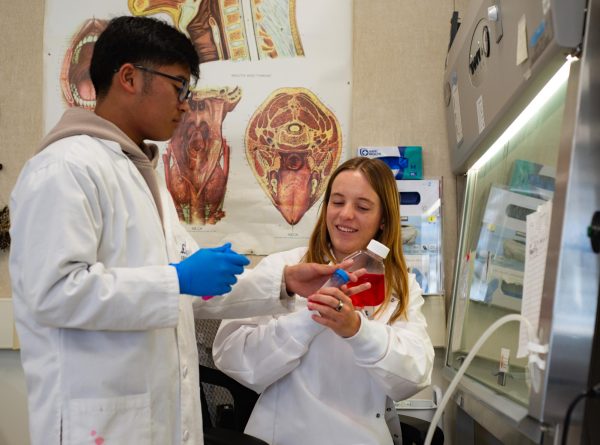
To fight cancer’s ability to evade and trick the immune system, senior Cameron Draeger and junior Theodore Santos’ project attempts to increase receptiveness for immunotherapy. Through inserting specific genes that code for proteins on the surface of cancer cells, they hoped to make treatment more effective.
“The issue with cancer cells is that they mutate a bunch,” Cameron said. “They lose the genes targeted by immunotherapy because of natural selection. We want to force the cancer cells to show its real cards.”
Their lab protocol inserts two genes called beta-2 microglobulin (B2M) and tapasin (TAPBP) through transient transfection. Inserting plasmids — circular DNA molecules with both genes — into the cell releases the new genes into the rest of the cell’s DNA. After the cell transcribes and translates, proteins would rise to the cell surface, becoming more susceptible to the immune system.
“I have many family members who have passed away from cancer, and as one of the top causes of death, it’s super significant,” Cameron said. “I’ve always been really fascinated with cancer — it’s just a very interesting disease, being destroyed by our own cells.”
Earlier in the year, they decided to investigate lung cancer cells specifically. But Synopsys required a particularly difficult cell line that didn’t want to take up the genes.
“Even experts have a hard time working with these,” ASI Teacher Tory Johnson said. “There were obstacles put in their way that weren’t their doing. They worked really hard on it, and if we’d had a different cell line to work with and not the limitations of a high school lab, I know they would’ve gotten beautiful data.”
This problem still persists for the duo, but they’re still determined to get as far as they can. Theo reaches out to professionals in the field and Cameron spends multiple free periods working in the lab to make the most of this opportunity.
Through their research, they’ve found that their skills balance each other well.
“Cameron always thinks of a lot of great ideas and I’ll come at it more technically, which makes us a great team,” Theo said. “She’s also a really good teacher.”
At Synopsys, Cameron was sick and unable to attend, leaving Theo to present alone. Since he missed lab work that Cameron conducted during her free periods, he didn’t know all the specifics of the lab parts. Regardless, he presented to the judges well, with coaching from Cameron and Johnson.
“It was stressful not having Cam there, especially because she had put so much into the project,” Theo said. “This class has definitely been a huge learning experience.”
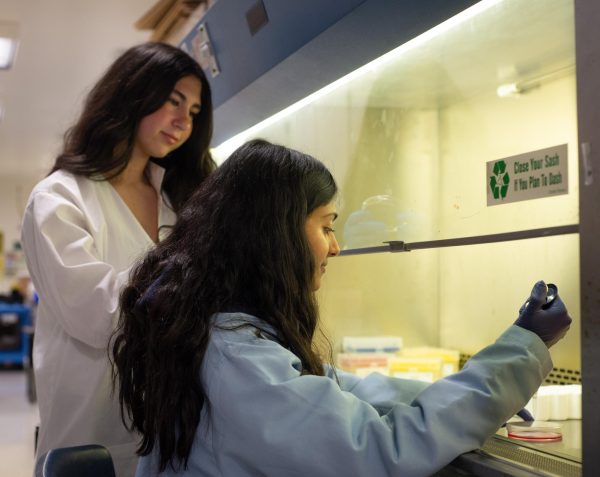
Telomeres — the ends of chromosomes — play active roles in cancer and aging. Seniors Liv Weiner and Shreya Goyalpatel tackle exactly that. Every time a normal cell divides, the telomeres get shorter until the cell dies. To prevent death, the enzyme telomerase rebuilds those telomeres, which allows cells to continue to divide.
By using natural inhibitors like curcumin, MST-312, and quercetin, they aim to prevent cancer cells from proliferating by inhibiting the enzyme from lengthening telomeres.
“In brief, we’re using compounds to try and prevent cancer — lung cancer, specifically — from continuing to divide,” Liv said.
Their daily work typically involves conducting wet lab research with cells. After growing the lung cancer cells and creating solutions and treatments, they conducted an MTT assay — a test that evaluates cell viability after treatment. With different concentrations and combinations of the inhibitors mentioned above, Liv and Shreya tested three solutions.
The optimal result would be reduced viability after exposure to their treatments. Although they are still in the process of analyzing their data, the duo have seen a promising correlation between MST-312, as well as curcumin, and reduced cancer cell viability.
“Science, especially wet labs and experiments, is always more complex than you anticipate,” Liv said. “It’s a lot of trial and error, and a lot of reading and reworking.”
“We also have to rely on technology for a lot of our assays,” Shreya said. “Recently, when we were conducting our MTT assay our microplate reader broke down. There are a lot of roadblocks that you can’t always control.”
Despite those challenges, they successfully presented their project to Synopsys judges. Many judges had ideas they could improve their assays, which helped Liv and Shreya refine their approach to confirm their hypothesis and goal. They received an honorable mention in the Biological Science and Engineering category.
“Some students come in with kind of half-baked ideas that are overly simple,” Johnson said. “Liv and Shreya had a difficult topic, they’d done a lot of work on it, and they were able to answer difficult questions.”
Moving forward, they plan to conduct a TRAP assay, which measures the levels of telomerase in the cells. Not only do they want to see a difference in the number of lung cancer cells, they want to ensure a direct correlation with decreased levels of telomerase and their treatment.
“As scientists and as people, we go into any project feeling like we can actually touch and help people’s lives,” Liv said. “That’s our goal with anything.”
With results from their data, they hope to be able to provide an accessible source of treatment for those vulnerable to lung cancer.

(Milan Grbovic)
Seniors Osvaldo Valenzuela and Sumedh Kothari’s project takes a unique approach to carbon dioxide emissions, using Metal-Organic Frameworks (MOFs) for carbon capture.
MOFs are a class of porous 3D chemical structures used from pharmaceuticals to semiconductors. One of their main uses is storing gases, such as carbon dioxide or hydrogen. Scientists have researched using MOFs for carbon capture, as they can release those stored gasses and be reused.
“You can capture the gas from a source, like a power plant or car,” Sumedh said. “Then, you can heat up those MOFs to release the carbon dioxide and store it somewhere else.”
While MOFs have the potential to fight climate change, they tend to fall apart in humid conditions, making them hard to work with. Their project aims to rectify this flaw by swapping certain atoms in the MOFs’ structure with fluorine, which is hydrophobic and could make the MOF more resistant to humid temperatures.
Ozvaldo and Sumedh started by examining review papers looking for prior research on the topic. Using that information, they set up different experiments changing different factors, such as switching compounds, methods, or working in a different time frame.
“It’s a small-scale experiment where you test different methods,” Sumedh said. “If it’s very successful, then you consider scaling it up.”
While running their first synthesis procedure, they encountered the issue where they didn’t achieve the desired structure of the MOF after adding fluorine.
“We were only able to synthesize half of it,” Sumedh said. “That was ultimately unsuccessful for our project’s purpose.”
Then, they decided to pivot their approach, trying a new method for adding fluoride to their MOFs, and developed two new synthesis methods. One of the methods has been fully completed, and they are currently developing the other.
“Apart from the really scientific portion, you have to have a vision and some creativity and be willing to just try different things,” Osvaldo said.
Their ability to experiment with out of the ordinary methods stems from their confidence while facing setbacks.
“Every time something doesn’t work, they just keep on trying,” Dressen said. “They come back. I think their ability to take setbacks like it’s no big deal and not be bothered is one of their best qualities.”

Seniors Abhinav Katsuri and Takumi Britt have spent the past year working with worms. Their goal? To find a transcription factor — a protein that regulates the transcription of genetic information — that helps with sleep disorders. Their hard work paid off — Abhinav and Takumi’s poster took first place in their category at Synopsys, earning them a spot at the state’s California Science and Engineering Fair, where only top contestants of Synopsis are invited to.
“Our research identifies this transcription factor, aptf-1, as a novel genetic regulator for that sleep-wake transition,” Abhinav said.
They jumped into their project recognizing a problem: people with sleep-wake disorders such as narcolepsy and insomnia experience sensory misperception during the transition from sleep to wakefulness. With the guidance of mentors from the University of Pennsylvania and Stanford, Abhiav and Takumi used C. elegans — worms often used in biological research — to explore how and why changes in sensory perception between sleep and wakefulness work.
“If you have this transcription factor in good working condition, then it is able to regulate that transition,” Abhinav said. “It ensures that when you go to sleep, you stay still, and that when you wake up, you perceive the world well. But when you don’t have that, you perceive the world in a completely different, much slower way.”
Abhinav and Takumi found that sleep-wake transitions depend on the transcription factor. To achieve a ‘healthy sleep cycle’ with stable rest, one requires a healthy functioning aptf-1.
To get to such a conclusion, they worked with C. elegans to test analogs between humans and worms. Using optogenetics, a light-dependent process, they gave the C. elegans a light-sensitive compound to activate certain neurons.
But, this came with technical issues too.
“The problem is, because it’s light sensitive, we can’t actually give it to them in light,” Abhinav said.
Abhinav and Takumi spent most of their fourth period ASI classes inside a dark storage room-turned-workshop observing their C. elegans, gathering data, and putting the compound in the worms.
“They had to work in the dark, and so I didn’t see them a lot,” Johnson said. “Someone would go, ‘Where are they?’ And it’s like, ‘Oh they’re in the back closet working with worms.’”
The discovery of aptf-1 lays a foundation for the next steps in researching the biology of sleep. Though the transcription factor isn’t a treatment, it’s a pathway for researchers to target.
“Their stuff is pretty sophisticated — it’s not just observing worms, but setting up a special condition with them,” Johnson said. “That’s what made the project unique and more of a challenge.”




